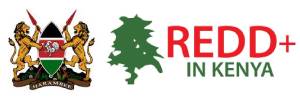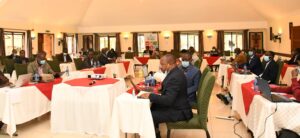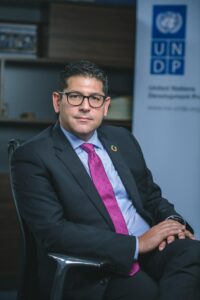1. What is carbon trading?
Carbon trading refers to a process where firms (or countries) buy and sell carbon credits generated as part of a programme to reduce greenhouse gas emissions. Developed countries buy these credits from developing countries to honor their commitments to the UNFCCC to reducing greenhouse gases. Multinational companies and NGOs also buy credits from developing countries as part of their corporate social responsibility. Carbon credits are basically certificates that allow parties to engage in activities that contribute to climate change mitigation by reducing emission of greenhouse gases or increasing afforestation, reforestation and forest restoration efforts. A single credit is equivalent to a ton of carbon dioxide that is absorbed from the atmosphere by growing trees or saved from being released into the atmosphere.
2. What is REDD+?
REDD + is an abbreviation for Reducing Emissions from Deforestation and forest Degradation, and the role of Sustainable Management of Forests and Enhancement of Forest carbon stocks in Developing Countries. REDD + is a climate change mitigation strategy that encourages developing countries like Kenya to reduce the rate of deforestation and forest degradation and to support sustainable management and conservation of available forest areas. The basic idea in REDD+ is that tropical developing countries like Kenya, will be encouraged through incentives to: reduce the rate of deforestation and forest degradation; conserve their forests through sustainable management; and to increase areas under forest cover. This is because when forests are destroyed, they release greenhouse gases that are responsible for Climate Change. Developing countries are rewarded or compensated for engaging in deliberate policy approaches and actions for conservation, enhancement of forest stocks and sustainable management of forests.
3. How Does REDD+ Work?
The basic idea of REDD+ is fairly straightforward: · Trees are made of carbon. · Cutting and burning trees releases a significant amount of carbon dioxide into the atmosphere and contributes to climate change. If Kenya can slow down the rate of forest destruction, by reducing deforestation and forest degradation, it can receive payments from international programs that seek to reduce this carbon pollution. Kenya can also receive payments for maintaining and sustainably managing and conserving its forests and therefore preventing escape of carbon into the atmosphere. In addition, if Kenyans can plant more trees through afforestation and reforestation activities, carbon is removed from the atmosphere and further payments can be made. Kenya can then invest that money in programs to help further conserve the forests and create a diverse set of economic opportunities and jobs for local people.
4. How will Kenya save its forests through the REDD+ program?
Kenya plans to save its forests through the REDD+ program by promoting and providing incentives that seek to: i Prevent further conversion of forest lands to other uses and reclaiming degraded forest areas ii Protect and sustainably manage important water catchment, including the five water towers iii Promote energy conservation technologies to reduce fuel-wood consumption Building the capacities of local communities to enable them to participate in forest management and conservation activities iv Strengthen and empower institutions through capacity enhancement for sustainable forest management v Monitor the status of our forest through ground and aerial surveys and make strategic responses to forest crisis as they occur vi Increase afforestation and reforestation to reduce the current national timber deficit vii Improving on fire monitoring and management viii Provide incentives, particularly payment for environmental services and tax holidays / tax rebates
5. Why the Need For Participation of Stakeholders in REDD+?
REDD+ will be implemented in a multi-sectorial and integrated manner. As many of the drivers of deforestation are outside of the forest sector, it requires the active engagement of the relevant agencies and stakeholders in the development and implementation of REDD+ activities. Therefore, the process of preparation for REDD+ readiness must be inclusive and transparent. Multistakeholder consultation and participation (C&P) will therefore be emphasized in every phase of the process. C&P aims to enhance transparency and accountability and enable the exploration of risks and opportunities associated with REDD+, especially from the perspective of: forest dependent communities, gender, issues and the most vulnerable groups. Furthermore, C&P will also support the development of a pro-poor strategies/policy and institutional framework that is socially inclusive, transparent and supportive of forest governance in the country. Inclusive participation of stakeholders seeks to ensure that interventions to achieve reduced emissions from deforestation and forest degradation deliver multiple benefits to local communities including the sustainable management of biodiversity, the provision of alternative livelihoods, equitable benefit sharing of revenues generating from emissions reductions, etc. Furthermore there is recognition that the sustainability of REDD+ must take into consideration the active engagement and participation of forest dependent people and other forest communities into the planning and decision making process of REDD.
6. What has Kenya done so far toward advancing REDD+?
Kenya’s decision to join the REDD+ process is, among other things, an opportunity to use an international process to achieve its own objectives to mitigate losses of forest cover, protect available forests and increase forest cover as enshrined in the Constitution. Kenya has embarked on the process of REDD+ Readiness supported by the Forest Carbon Partnership Facility (FCPF), the United Nation Programme on REDD+ (UN-REDD) and other development partners . Towards this, Kenya has a REDD+ Readiness Preparation Proposal (RPP) that broadly provides a framework of readiness activities and the roadmap for these efforts.
The REDD+ process in the country intends to achieve four goals:
- Realization of Constitutional and vision 2030 objectives of increasing forest cover to a minimum of 10%;
- Support to government’s efforts in designing policies and measures to protect and improve its remaining forest resources in ways that improve local livelihoods and conserve biodiversity;
- Realization of the goals of the National Climate Change Response Strategy; and,
- Contribution to global climate change mitigation and adaptation efforts. A number of analytical studies have been undertaken to support the REDD+ strategy formulation process, which include important REDD+ governance dimensions, such as corruption risks assessment , carbon rights and benefit-sharing, assessment of legal preparedness for REDD+, and the assessment of the forest sector and its contribution to the green economy. FCPF and World Bank Support has enabled the country to undertake detailed studies of drivers of forest cover change, charcoal value chain analysis, demand and supply of wood products and appropriate grazing management systems for dry land forest as REDD+ options. In addition, Kenya has developed a detailed Terms of Reference for Strategic Environment and Social Assessment (SESA) for REDD+ and a draft Feedback and Grievance Redress Mechanism (FGRM) to support the REDD+ strategy formulation process. Equally ongoing is capacity development to stakeholders, including forest dependent communities, to ensure inclusive participation in REDD+ efforts in the country. A detailed Road Map for the establishment of baselines and the National Forest Monitoring System has been consultatively developed. It is currently being updated, with technical and financial support from FAO, to include a detailed work plan, timelines and budget. Further, the Government, has initiated a programme of establishing a comprehensive System for Land-based Emission Estimation (SLEEK) of GHGs resulting from changes in land use. A detailed national forest cover mapping was carried out in 2013 to map the forest resource at national level to serve as a basis for assessment of developing the forest monitoring system and as a basis for assessing performance of forest interventions in future.


